SEO Best Practices Every Online Business Owner Should Know

Are you aware that SEO knowledge is essential not only for SEO experts? Both big brands and small business owners should know how SEO works for their websites.
First of all, the biggest mistake a small business can make is to hire a low-quality SEO company. Yes, it’ll help you save money. No, it won’t bring you the desired result. If you can’t afford experienced specialists, why not do it by yourself? Then, at least, high quality is guaranteed.
Moreover, even if you’re running a successful brand and working with the best SEO experts, don’t you want to know what you’re paying for? Understanding all business processes – including SEO – is what sets apart the good managers from the bad ones.
So, get ready to discover the best SEO practices that work to improve your organic ranking:
- How search works
- Google Analytics account creation
- Keyword research
- Target audience investigation
- Competitor analysis
- Technical optimization
- Building E-A-T
- Evaluating results
How search works
Let’s start with the basics. Before starting search engine optimization, you should know how your website gets ranked in Google or other search engines. The process isn’t that difficult to understand:
- Crawling. At the first stage, search crawlers find your website or its new pages and collect all the necessary data. These robots scan pages and follow links they contain in the same manner that users do. The most important thing to note is that different content has a different priority for crawlers. For example, first of all, robots look for such files as robot.txt and Sitemap to get directions as to which pages are the most important.
- Indexing. The time required for this action varies from 2 days to 2 months. At this stage, robots analyze the data they got from your page and register it in the search engine database.
- Ranking. This is the process of sorting the web pages in descending order of their relevance to the search questions.
To improve indexing and ranking, you should optimize your website properly. Here are the most important ranking factors:
- Keywords usage.
- Users’ behavior, especially the time they spend on your site.
- Site speed.
- Visual elements optimization.
- Site structure.
- Trustworthiness of inbound links.
- Quality of external links.
- Mobile Usability.
It’s pretty challenging to keep up with all search engines’ requirements without a set guide. Here, I’ve circled out the most essential steps to a successful SEO of your site.
Google Analytics account creation
As optimization is impossible without analytics, you’ll need to use various SEO tools. These will help you process and understand your website’s data, such as traffic and conversions, to discover your site’s strengths and weaknesses.
The next step after creating a website should be signing up to Google Analytics. This service will provide you with almost all the website statistics you need on the long journey of internet marketing.
Keyword research
Keywords are among the most crucial factors that have a direct impact on how your website will get ranked in search results. These are words or phrases that people enter into the search field when searching for a product, service or information online.
It’s not as easy as it seems. The problem is that you are an expert in your specific field, while your potential customers probably aren’t. They may use different keywords than the ones you’d expect when they are searching online. With keyword research, you’ll better understand what phrases your audience uses when searching for products or information you provide.
There are several tips to successful keyword research:
- Brainstorm. Think of the words and word combinations best-describing the subject(s) on your website. Make a list.
- Use keyword research tools. You can go with such services as Ahrefs, SEMrush, Serpstat or Moz. Enter one of the words you came up with into the search field, and you’ll see all the keyword suggestions:
- Set clear intent. If you are selling a product, turn your focus toward phrases with commercial intent. These phrases are most likely to bring you potential customers.
- Consider volume and keyword difficulty level. The most challenging part is selecting high volume words whose keyword difficulty level is not that high. The best way to do this is with long tail keywords. Long tail keywords are phrases consisting of three or four words. As they are more focused and specific, they are used by people who are more specific in their search, and therefore more likely to convert. (For example, “birthday cake” versus the long tail keyword “Healthy vegan chocolate birthday cake.”)
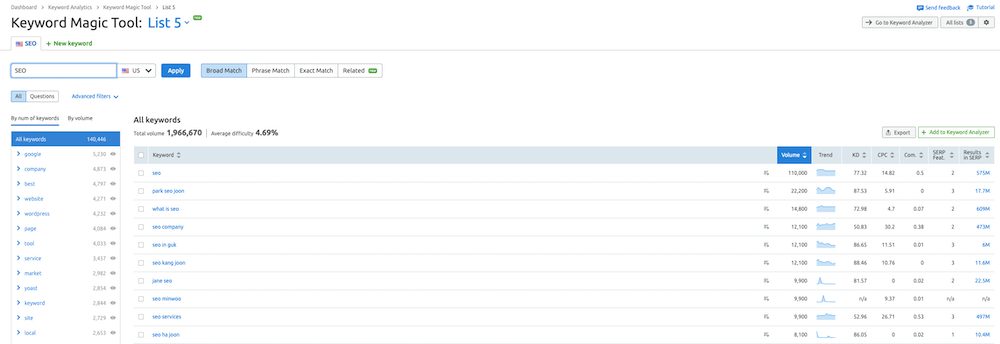
Target audience investigation
When you decide to launch a new website or optimize an existing one, it’s essential to find out who your audience is. This will help you increase the conversion rate, as you’ll be better able to appeal to people who are already interested in what you have to offer.
Common target demographics include:
- Age
- Gender
- Location
- Language
- Interests
- Profession
Remember, there’s a great difference between knowing who your visitors are and supposing that you know. So, make sure you’ve thoroughly checked your audience data.
If you already have a site and an account in Google Analytics, then identifying your target audience will be pretty easy. In the Audience folder, you’ll find data on your visitors’ demographics:
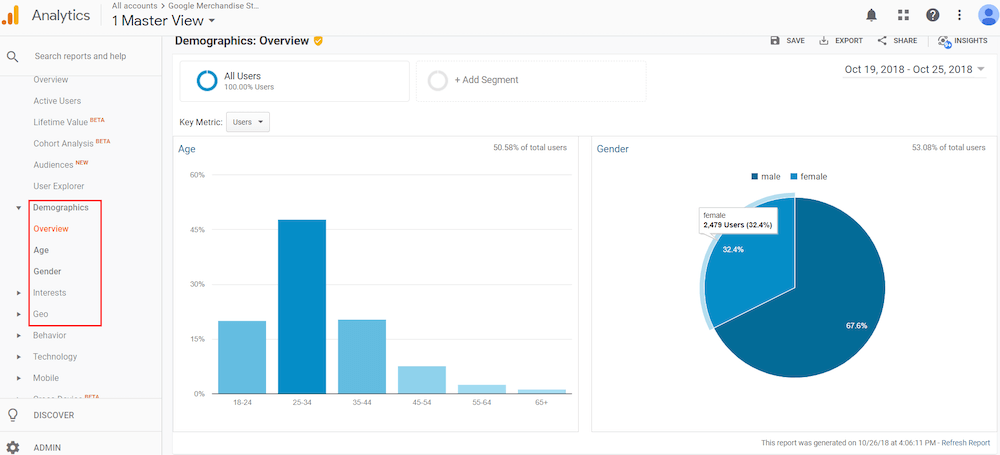
Up till now, we’ve discussed ways you can improve your SEO if you have an existing website. However, in order to really optimize your site SEO, there are loads of important things you can do when you are planning, designing and programming your site.
If you haven’t yet created your website, the next section is applicable to you.
Competitor analysis
People who neglect this part of the SEO process lose a great opportunity to avoid future mistakes and to correct those they’ve already made. Competitor analysis will help you:
- Understand the current situation in your market niche.
- Discover the areas you should expand on to surpass your competitors.
- Find out the most successful strategies your rivals are using.
- Identify strategies your competitors don’t use (and neither should you).
Of course, before you start the analysis, you should know exactly who the market players are. You can enter your main keywords in the search field and see the domains that are ranked with the same words. Although it’s the easiest way of identifying your search competitors, this data won’t be precise.
If you go with SEO tools, such as Serpstat or Ahrefs, you’ll find out your closest rivals according to all the keywords you use. Here’s how the process looks with Ahrefs:
First, enter your domain, then go to Competing Domains. This shows you a list of the URLs of your competitors.
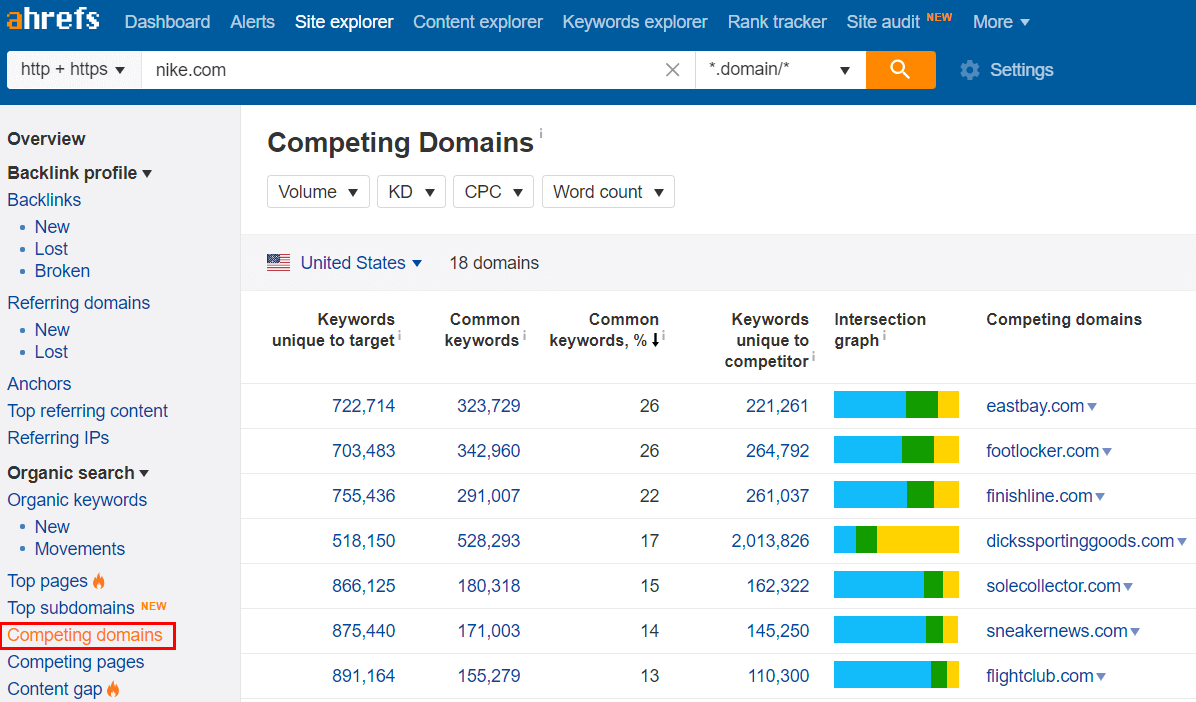
When you’ve defined who the market players are, you should undertake a competitive analysis via the following steps:
- Identify their traffic sources. SimilarWeb is very convenient for this purpose.
- Research keywords they use.
- Analyze backlinks they get.
- Audit their meta tags and content.
- Consider their site structure.
Technical optimization
This step is the most important if you want to speed up the process of indexing your website. Technical SEO audit will help you lay a foundation for good ranking. Here are the factors you should consider first and foremost when optimizing your website technically:
Page speed. If you want to create an engaging design and add various images, videos or documents, note that all these features affect your page speed.
Time needed for loading is one of the factors that are important not only for crawlers but also for your visitors’ experience on your site – people won’t wait long for your webpage to load. Use Google’s PageSpeed Insight to monitor your website speed.
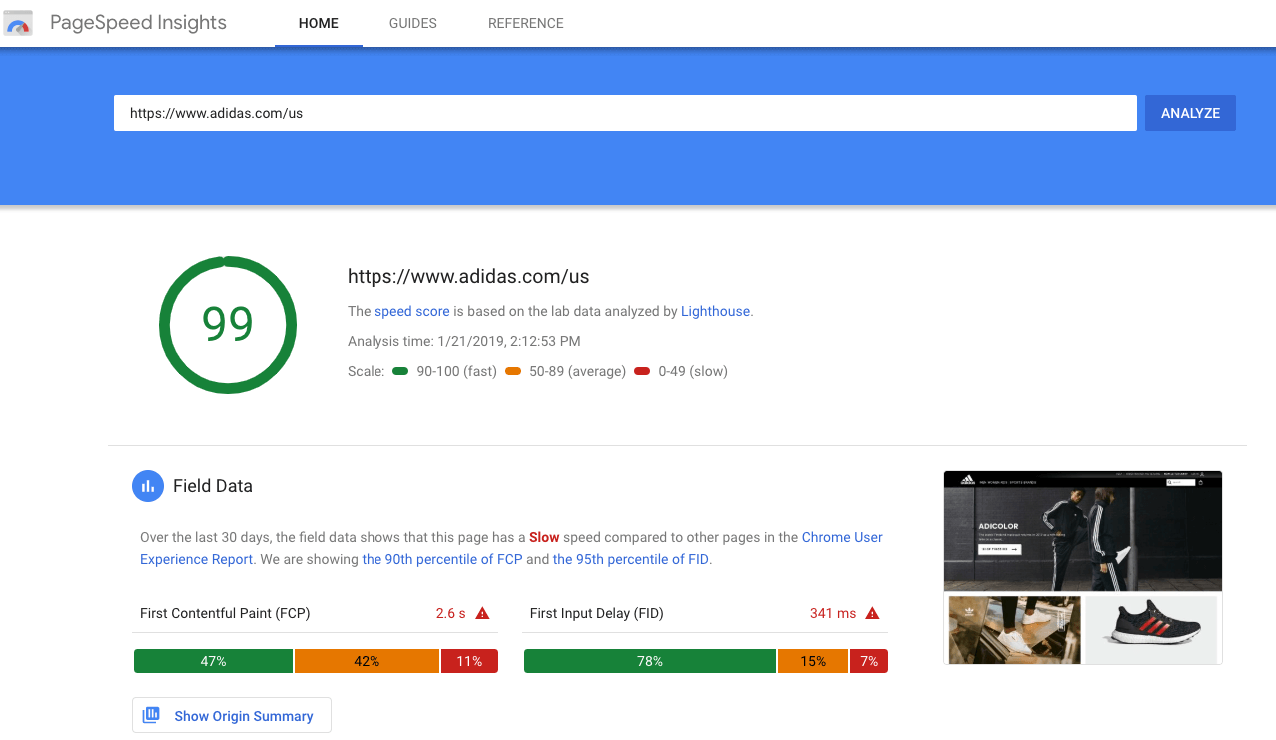
Don’t forget to analyze the mobile version speed as well. From July 28, Google page speed has been a ranking factor for mobile searches.
Site architecture
Provide a clear structure of your website for search robots to easily find the website directions during the crawl. The following aspects will help you build a proper site architecture:
- File robots.txt. This file should contain directives for search robots. Create this file so that crawlers won’t go to pages they don’t need to index.
- Sitemap. With this file, you can provide a clear website structure to highlight your site’s key elements for search engines.
- Logically grouped content. For example, if you own an online shop, always group products in different categories.
- URL structure. A quality URL can represent the logically grouped hierarchy of your website’s pages. It helps search engines understand the structure of your website better.
- Internal links. Such links are essential for improving your older posts’ visibility when they are topically related to your new articles. If you link to the pages within one category, your users will be able to follow from one post to another, increasing the time spent on your website.
- Eliminate duplicate content. First of all, check, whether your website contains pages with similar content. It’s convenient to use Siteliner for this purpose.
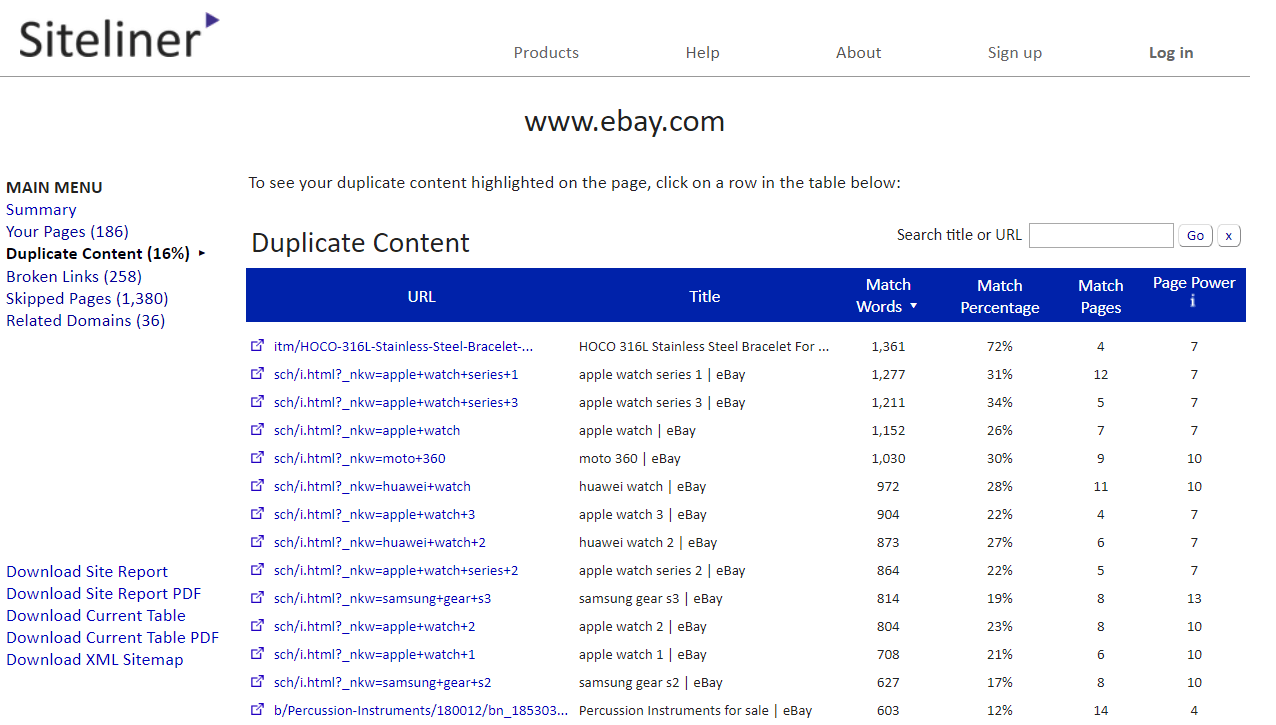
When faced with duplicate pages, content crawlers can’t decide which page to prioritize. You should either remove the duplicate page or:
- Add ‘rel=canonical’ to the original page;
- Use 301 redirect from the duplicates to the page with the original content.
Status codes
A page returns status codes responding to a user’s request. You don’t have to know all the status codes, but here are the most important ones:
- 200: OK. The request has succeeded.
- 301: The page moved permanently. Users are redirected to another address.
- 302: The page moved temporarily.
- 404: Not found. The server hasn’t found any page matching the request.
- 500: Internal server error. The server couldn’t fulfill the request, as some unexpected condition was encountered.
- 503: Service unavailable. The server is currently unable to answer and asks to come back later.
4xx and 5xx errors can affect your ranking badly, so make sure you’ve checked the server parameters and removed links that lead to 4xx pages.
These are the primary factors you should optimize from the very beginning. There are many more factors that you should take into consideration, such as meta tags, visuals, mobile version, etc.
Use Serpstat Site Audit to find all the technical mistakes you may have made, and discover how you can correct them. Simply create a project for your domain, click on Start Audit, choose settings, and wait for the results:
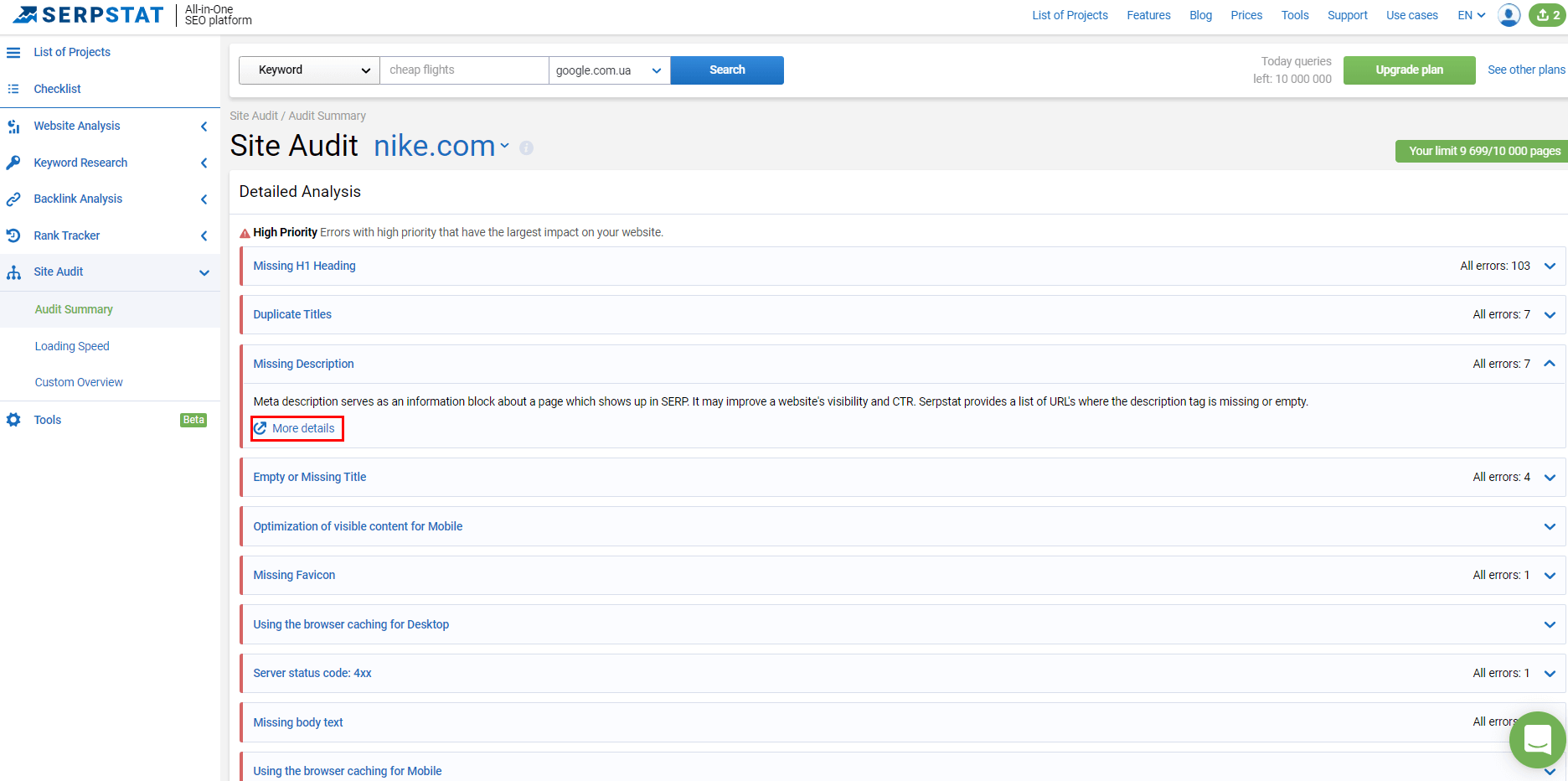
Building E-A-T
Before we begin, what is E-A-T? The abbreviation stands for Expertise, Authority, and Trustworthiness. Let’s investigate what each word means for your SEO:
- Expertise. To build expertise, you should show you’re qualified enough in the sphere.
- Authority. You and your voice should be authoritative in your niche.
- Trustworthy. The data you provide and the website itself should be trusted and not spammy.
How you can build E-A-T
As Google has stated, they use E-A-T factors to evaluate the quality of the website, so it’s essential to know how to build your E-A-T.
First of all, publish fresh and high-quality content. To create up-to-date posts, find out the most popular search questions. This information will help you discover the current subjects of interest among your target audience.
Go to Answer The Public, enter one of the keywords you use, and see all the questions users search for with this keyword:
Your link profile also has a significant impact on building your authority and trustworthiness. The more inbound and external links you have, the higher your authority is. Mind that your trustworthiness depends on how trusted the websites you get links from are. Choose only high-quality and relevant websites for linking.
Add About us, Privacy Policy, Terms of Service, and Contact us pages. They may seem not that engaging for your visitors, but they’re still very beneficial for your ranking. While crawling your website, search robots consider these sections ‘quality signals,’ as all the authority pages have them
Evaluating results
Remember how we discussed earlier the importance of creating a Google Analytics account? Now’s the right time to use all its features. After you created your website implementing the basic SEO practices, it’s time to evaluate the result and define your next steps to improving your marketing strategy.
With Google Analytics you can track the number of users, page views, performance against goals, etc.
Moreover, as SEO trends keep changing constantly, you should always review your analytics to find out new ways of optimizing your website.
As you can see, there are so many factors influencing your online success. Always remember that although it’s essential to fit the search engines’ requirements, the trust of your target audience is the priority.
So, make sure your website isn’t only rich with relevant keywords and technically optimized, but it also provides up-to-date, compelling and attractive content.













